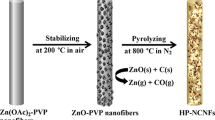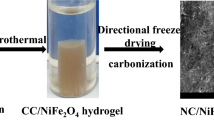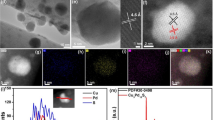Abstract
One-dimensional (1D) oxide nanofibers have attracted much attention in recent years but are still hampered by the difficulty in the expansion to 2D or 3D dimensions. Herein, ultrathin CeO2/SiO2 nanofibers with intriguing core–sheath structures were simply fabricated by a facile single-spinneret electrospinning method and were subsequently integrated as 2D nanofibrous mats and 3D sponges. Introducing secondary oxide (i.e., SiO2) could induce a unique fine structure and further inhibit the sintering of CeO2 nanocrystals, endowing the resultant dual-oxide nanofibers with high porosity, good flexibility, and enriched oxygen defects. Benefiting from the core–sheath structure and dual-oxide component, the CeO2/SiO2 nanofibers could stabilize 2.59 nm-Pt clusters against sintering at 600 °C. Once assembled into a 2D mat, the nanofibers could efficiently decrease the soot oxidation temperature by 63 °C. Moreover, the core–sheath CeO2/SiO2 nanofibers can be readily integrated with graphene nanosheets into a 3D sponge via a gas foaming protocol, showing 218.5 mg/g of adsorption capacity toward Rhodamine B molecules. This work shed lights on the versatile applications of oxide nanofibers toward clean energy ultilization and low-carbon development.
Graphical abstract
Ultrathin core–sheath CeO2/SiO2 nanofibers were fabricated by a facile single-spinneret electrospinning method and were subsequently integrated as 2D nanofibrous mats and 3D sponges, exhibiting desirable efficiency in heterogeneous catalysis and water remediation.







Similar content being viewed by others
References
Mofarah S, Adabifiroozjaei E, Yao Y, Koshy P, Lim S, Webster R, Liu X, Khayyam R, Cazorla C, Liu Z, Wang Y, Lambropoulos N, Sorrell C. Proton-assisted creation of controllable volumetric oxygen vacancies in ultrathin CeO2−x for pseudocapacitive energy storage applications. Nat Commun 2019;10:2594.
Parastaev A, Muravev V, Huertas E, Hoof A, Kimpel T, Kosinov N, Hensen E. Boosting CO2 hydrogenation via size-dependent metal–support interactions in cobalt/ceria-based catalysts. Nat Catal 2020;3:526.
Peng H, Rao C, Zhang N, Wang X, Liu W, Mao W, Han L, Zhang P, Dai S. Confined ultrathin Pd-Ce nanowires with outstanding moisture and SO2 tolerance in methane combustion. Angew Chem Int Ed 2018;57:8953.
Wang Z, Yu R. Hollow micro/nanostructured ceria–based materials: synthetic strategies and versatile applications. Adv Mater 2019;31:1800592.
Feng X, Liu D, Yan B, Shao M, Hao Z, Yuan G, Yu H, Zhang Y. Highly active PdO/Mn3O4/CeO2 nanocomposites supported on one dimensional halloysite nanotubes for photoassisted thermal catalytic methane combustion. Angew Chem Int Ed 2021;60:18552.
Lei Y, Wang Q, Peng S, Ramakrishna S, Zhang D, Zhou K. Electrospun inorganic nanofibers for oxygen electrocatalysis: design, fabrication, and progress. Adv Energy Mater 2020;10:1902115.
Shi S, Si Y, Han Y, Wu T, Iqbal M, Fei B, Li R, Hu J, Qu J. Recent progress in protective membranes fabricated via electrospinning: advanced materials, biomimetic structures, and functional applications. Adv Mater 2022;34:2107938.
Xue J, Wu T, Dai Y, Xia Y. Electrospinning and electrospun nanofibers: methods, materials, and applications. Chem Rev 2019;119:5298.
Li Z, Liu S, Song S, Xu W, Sun Y, Dai Y. Porous ceramic nanofibers as new catalysts toward heterogeneous reactions. Compos Commun 2019;15:168.
Yoon K, Yang Y, Lu P, Wan D, Peng H, Stamm K, Fanson P, Campbell C, Xia Y. A highly reactive and sinter-resistant catalytic system based on platinum nanoparticles embedded in the inner surfaces of CeO2 hollow fibers. Angew Chem Int Ed 2012;51:9543.
Hu S, Li W. Sabatier principle of metal–support interaction for design of ultrastable metal nanocatalysts. Science 2021;374:1360.
Lu L, Yang B, Zhai Y, Liu J. Electrospinning core-sheath piezoelectric microfibers for self-powered stitchable sensor. Nano Energy 2020;76:104966.
Liu S, Tian J, Yin K, Li Z, Meng X, Zhu M, Seeram R, Sun Y, Dai Y. Constructing fibril-in-tube structures in ultrathin CeO2-based nanofibers as the ideal support for stabilizing Pt nanoparticles. Mater Today Chem 2020;17:100333.
Gao M, Zhou W, Mo Y, Sheng T, Deng Y, Chen L, Wang K, Tan Y, Zhou H. Outstanding long-cycling lithium−sulfur batteries by core-shell structure of S@Pt composite with ultrahigh sulfur content. Adv Powder Mater 2021. https://doi.org/10.1016/j.apmate.2021.09.006 .
Yu Z, Li F, Zhu Q. Single-source-precursor synthesis and phase evolution of NbC-SiC-C ceramic nanocomposites with core–shell structured NbC@C and SiC@C nanoparticles. Adv Powder Mater 2021. https://doi.org/10.1016/j.apmate.2021.09.009 .
Fu W, Dai Y, Li J, Liu Z, Yang Y, Sun Y, Huang Y, Ma R, Zhang L, Sun Y. Unusual hollow Al2O3 nanofibers with loofah-like skins: intriguing catalyst supports for thermal stabilization of Pt nanocrystals. ACS Appl Mater Interfaces 2017;9:21258.
Yao L, Pan W, Luo J, Zhao X, Cheng J, Nishijima H. Stabilizing nanocrystalline oxide nanofibers at elevated temperatures by coating nanoscale surface amorphous films. Nano Lett 2018;18:130.
Yuan D, Zhang T, Guo Q, Qiu F, Yang D, Ou Z. Recyclable biomass carbon@SiO2@MnO2 aerogel with hierarchical structures for fast and selective oil-water separation. Chem Eng J 2018;351:622.
Han X, Ding S, Fan L, Zhou Y, Wang S. Janus biocomposite aerogels constituted of cellulose nanofibrils and MXenes for application as single-module solar-driven interfacial evaporators. J Mater Chem A 2021;9:18614.
Rong S, He T, Zhang P. Self-assembly of MnO2 nanostructures into high purity three-dimensional framework for high efficiency formaldehyde mineralization. Appl Catal B 2020;267:118375.
Dai Y, Sun Y, Yao J, Ling D, Wang Y, Long H, Wang X, Lin B, Zeng T, Sun Y. Graphene-wrapped TiO2 nanofibers with effective interfacial coupling as ultrafast electron transfer bridges in novel photoanodes. J Mater Chem A 2014;2:1060.
Fu W, Li Z, Xu W, Wang Y, Sun Y, Dai Y. Exceptionally thermal-stable Al2O3/TiO2 nanofibers by depressing surface-initiated grain growth as new supports for anti-sintering Pt nanoparticles. Mater Today Nano 2020;11:100088.
Yu T, Zeng J, Lim B, Xia Y. Aqueous-phase synthesis of Pt/CeO2 hybrid nanostructures and their catalytic properties. Adv Mater 2010;22:5188.
Liu B, Li C, Zhang G, Yao X, Chuang S, Li Z. Oxygen vacancy promoting dimethyl carbonate synthesis from CO2 and methanol over Zr-doped CeO2 nanorods. ACS Catal 2018;8:10446.
Huang Y, Long B, Tang M, Rui Z, Balogun M, Tong Y, Ji H. Bifunctional catalytic material: an ultrastable and high-performance surface defect CeO2 nanosheets for formaldehyde thermal oxidation and photocatalytic oxidation. Appl Catal B 2016;181:779.
Dai Y, Lim B, Yang Y, Cobley C, Li W, Cho E, Grayson B, Fanson P, Campbell C, Sun Y, Xia Y. A sinter-resistant catalytic system based on platinum nanoparticles supported on TiO2 nanofibers and covered by porous silica. Angew Chem Int Ed 2010;49:8165.
Xue J, Xie J, Liu W, Xia Y. Electrospun nanofibers: new concepts, materials, and applications. Acc Chem Res 1976;2017:50.
He R, Wang Y, Wang X, Wang Z, Liu G, Zhou W, Wen L, Li Q, Wang X, Chen X, Zeng J, Hou J. Facile synthesis of pentacle gold-copper alloy nanocrystals and their plasmonic and catalytic properties. Nat Commun 2014;5:4327.
Menumerov E, Hughes R, Neretina S. Catalytic reduction of 4-nitrophenol: a quantitative assessment of the role of dissolved oxygen in determining the induction time. Nano Lett 2016;16:7791.
Strachan J, Barnett C, Masters A, Maschmeyer T. 4-Nitrophenol reduction: probing the putative mechanism of the model reaction. ACS Catal 2020;10:5516.
Du J, Liu L, Yu Y, Zhang Y, Chen A. “Dissolution-reassembly” for N-doped hollow micro/meso-carbon spheres with high supercapacitor performance. Chin Chem Lett 2019;30:1423.
Wei Y, Jiao J, Zhang X, Jin B, Zhao Z, Xiong J, Li Y, Liu J, Li J. Catalysts of self-assembled Pt@CeO2-delta-rich core-shell nanoparticles on 3D ordered macroporous Ce1–xZrxO2 for soot oxidation: nanostructure-dependent catalytic activity. Nanoscale 2017;9:4558.
Fu W, Li Z, Wang Y, Sun Y, Dai Y. Stabilizing 3 nm-Pt nanoparticles in close proximity on rutile nanorods-decorated-TiO2 nanofibers by improving support uniformity for catalytic reactions. Chem Eng J 2020;401:1213031.
Huang T, Zhu Y, Zhu J, Yu H, Zhang Q, Zhu M. Self-reinforcement of light, temperature-resistant silica nanofibrous aerogels with tunable mechanical properties. Adv Fiber Mater 2020;2:338.
Budnyak T, Onwumere J, Pylypchuk I, Jaworski A, Chen J, Rokicinska A, Lindstrom M, Kustrowski P, Sevastyanova O, Slabon A. LignoPhot: conversion of hydrolysis lignin into the photoactive hybrid lignin/Bi4O5Br2/BiOBr composite for simultaneous dyes oxidation and Co2+ and Ni2+ recycling. Chemosphere 2021;279:130538.
Wang Z, Zhu C, Mo J, Fu P, Zhao Y, Yin S, Jiang J, Pan M, Su C. White-light emission from dual-way photon energy conversion in a dye-encapsulated metal-organic framework. Angew Chem Int Ed 2019;58:9752.
Acknowledgements
This work was financially supported by the Natural Science Foundation of China (21975042), the Project of Six Talents Climax Foundation of Jiangsu (XCL–082), Innovation Platform Project Supported by Jiangsu Province (6907041203), the Young Talent Lifting Project of Jiangsu Science and Technology Associate, the Fundamental Research Funds for the Central Universities, the Postgraduate Research & Practice Innovation Program of Jiangsu Province (KYCX22_0261), the Priority Academic Program Development of Jiangsu Higher Education Institutions, and the open project of State Key Laboratory of Physical Chemistry of Solid Surfaces in Xiamen University.
Author information
Authors and Affiliations
Corresponding authors
Ethics declarations
Conflict of interest
There are no conflicts to declare.
Additional information
Publisher's Note
Springer Nature remains neutral with regard to jurisdictional claims in published maps and institutional affiliations.
Supplementary Information
Below is the link to the electronic supplementary material.
Appendix A. Supplementary data
: Supplementary data related to this article can be found at (DOC 864 KB)
Rights and permissions
About this article
Cite this article
Wang, Y., Li, Z., Fu, W. et al. Core–Sheath CeO2/SiO2 Nanofibers as Nanoreactors for Stabilizing Sinter-Resistant Pt, Enhanced Catalytic Oxidation and Water Remediation. Adv. Fiber Mater. 4, 1278–1289 (2022). https://doi.org/10.1007/s42765-022-00177-0
Received:
Accepted:
Published:
Issue Date:
DOI: https://doi.org/10.1007/s42765-022-00177-0




